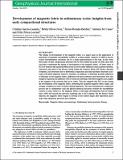Por favor, use este identificador para citar o enlazar a este item:
http://hdl.handle.net/10261/82385COMPARTIR / EXPORTAR:
 SHARE SHARE
 CORE
BASE CORE
BASE
|
|
| Visualizar otros formatos: MARC | Dublin Core | RDF | ORE | MODS | METS | DIDL | DATACITE | |

| Título: | Development of magnetic fabric in sedimentary rocks: Insights from early compactional structures |
Autor: | García-Lasanta, C.; Oliva-Urcia, Belén CSIC ORCID; Román-Berdiel, T.; Casas Cendoya, Ana María CSIC ORCID ; Pérez-Lorente, F. | Fecha de publicación: | 2013 | Editor: | Blackwell Publishing | Citación: | Geophysical Journal International 194: 182- 199 (2013) | Resumen: | The timing of development of the magnetic fabric is a major issue in the application of anisotropy of magnetic susceptibility (AMS) as a strain marker. Analysis of AMS in unconcealed synsedimentary structures can be a sound approximation to this task. In this work, three types of early compactional structures (ECS) were studied by means of AMS, since they can help to understand the timing of development of the magnetic fabric. All three types of ECS are found in fine-grained detrital rocks (to avoid other influences such as palaeocurrents), claystones and marls of the Enciso Group within the Cameros Basin (NE Spain): dinosaur footprints, load structures due to differential compaction and dish-and-flame structures associated with fluid migration related to seismites. In addition, to determine possible influences of lithology on the magnetic fabric, different rock types (siltstones and limestones) were also sampled. In general, the influence of ECS results in scattering of the three magnetic axes, higher at the margins of the structure than at its centre. This fact suggests that ECS occurs during the development of the magnetic fabric, disturbing the incipient magnetic fabric stages, and strongly conditions its later evolution during diagenesis. The later homogeneous compaction process due to sedimentary load and physicochemical processes reorient the susceptibility carriers to some extent (i.e. the magnetic fabric is still under development), but not totally, since AMS still records the previous scattering due to ECS imprint. For the Enciso Group deposits, the magnetic fabric begins to develop at the earliest stages after deposition and it stops when diagenetic processes have finished. | Versión del editor: | http://dx.doi.org/10.1093/gji/ggt098 | URI: | http://hdl.handle.net/10261/82385 | DOI: | 10.1093/gji/ggt098 | ISSN: | 0956-540X | E-ISSN: | 1365-246X |
| Aparece en las colecciones: | (IPE) Artículos |
Ficheros en este ítem:
| Fichero | Descripción | Tamaño | Formato | |
|---|---|---|---|---|
| Geophys. J. Int.-2013-García-Lasanta.pdf | 9,77 MB | Adobe PDF |  Visualizar/Abrir |
CORE Recommender
SCOPUSTM
Citations
27
checked on 22-abr-2024
WEB OF SCIENCETM
Citations
25
checked on 29-feb-2024
Page view(s)
500
checked on 24-abr-2024
Download(s)
369
checked on 24-abr-2024
Google ScholarTM
Check
Altmetric
Altmetric
NOTA: Los ítems de Digital.CSIC están protegidos por copyright, con todos los derechos reservados, a menos que se indique lo contrario.
